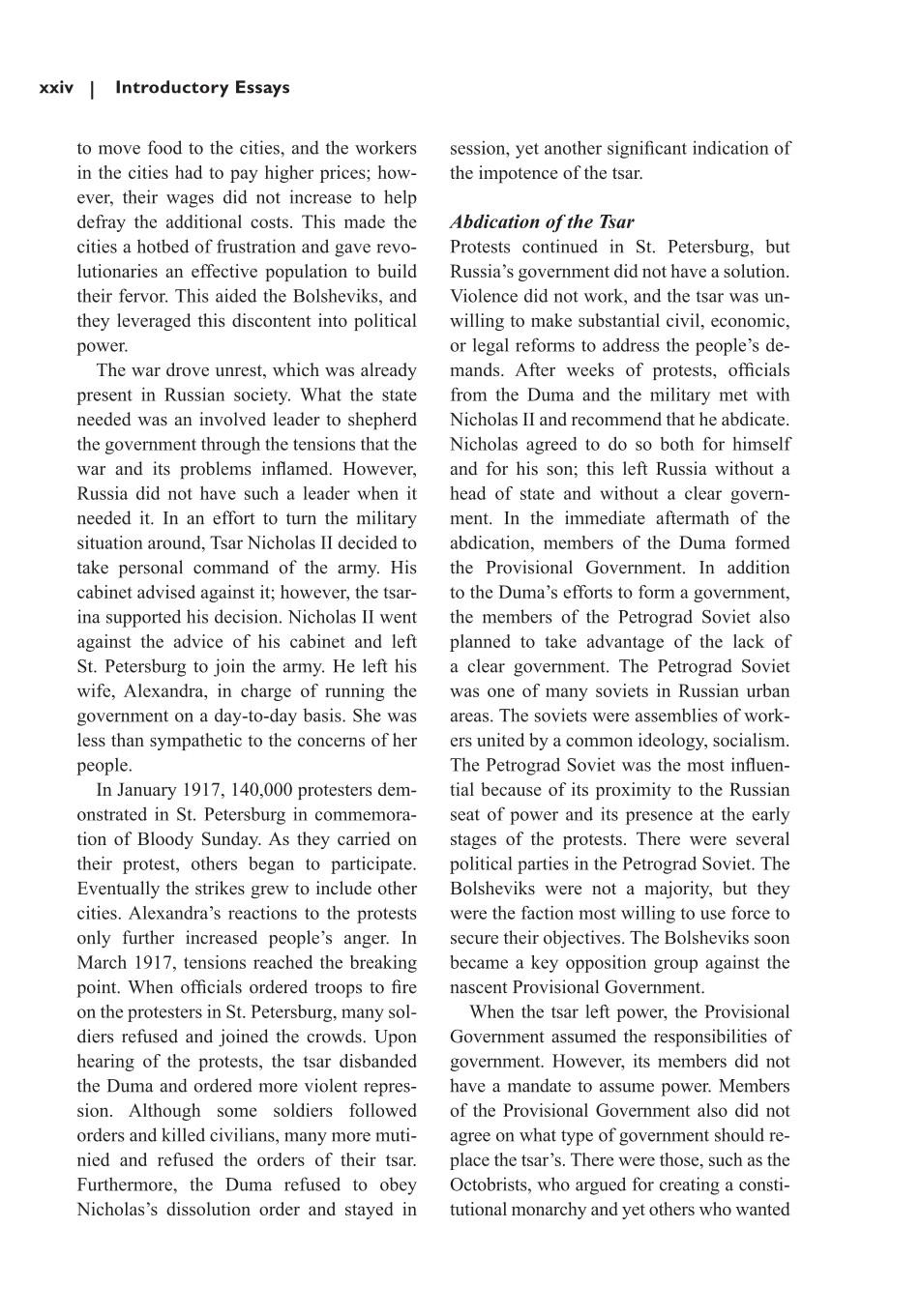| Introductory Essays xxiv
to move food to the cities, and the workers
in the cities had to pay higher prices; how-
ever, their wages did not increase to help
defray the additional costs. This made the
cities a hotbed of frustration and gave revo-
lutionaries an effective population to build
their fervor. This aided the Bolsheviks, and
they leveraged this discontent into political
power.
The war drove unrest, which was already
present in Russian society. What the state
needed was an involved leader to shepherd
the government through the tensions that the
war and its problems inflamed. However,
Russia did not have such a leader when it
needed it. In an effort to turn the military
situation around, Tsar Nicholas II decided to
take personal command of the army. His
cabinet advised against it; however, the tsar-
ina supported his decision. Nicholas II went
against the advice of his cabinet and left
St. Petersburg to join the army. He left his
wife, Alexandra, in charge of running the
government on a day-to-day basis. She was
less than sympathetic to the concerns of her
people.
In January 1917, 140,000 protesters dem-
onstrated in St. Petersburg in commemora-
tion of Bloody Sunday. As they carried on
their protest, others began to participate.
Eventually the strikes grew to include other
cities. Alexandra’s reactions to the protests
only further increased people’s anger. In
March 1917, tensions reached the breaking
point. When officials ordered troops to fire
on the protesters in St. Petersburg, many sol-
diers refused and joined the crowds. Upon
hearing of the protests, the tsar disbanded
the Duma and ordered more violent repres-
sion. Although some soldiers followed
orders and killed civilians, many more muti-
nied and refused the orders of their tsar.
Furthermore, the Duma refused to obey
Nicholas’s dissolution order and stayed in
session, yet another significant indication of
the impotence of the tsar.
Abdication of the Tsar
Protests continued in St. Petersburg, but
Russia’s government did not have a solution.
Violence did not work, and the tsar was un-
willing to make substantial civil, economic,
or legal reforms to address the people’s de-
mands. After weeks of protests, officials
from the Duma and the military met with
Nicholas II and recommend that he abdicate.
Nicholas agreed to do so both for himself
and for his son; this left Russia without a
head of state and without a clear govern-
ment. In the immediate aftermath of the
abdication, members of the Duma formed
the Provisional Government. In addition
to the Duma’s efforts to form a government,
the members of the Petrograd Soviet also
planned to take advantage of the lack of
a clear government. The Petrograd Soviet
was one of many soviets in Russian urban
areas. The soviets were assemblies of work-
ers united by a common ideology, socialism.
The Petrograd Soviet was the most influen-
tial because of its proximity to the Russian
seat of power and its presence at the early
stages of the protests. There were several
political parties in the Petrograd Soviet. The
Bolsheviks were not a majority, but they
were the faction most willing to use force to
secure their objectives. The Bolsheviks soon
became a key opposition group against the
nascent Provisional Government.
When the tsar left power, the Provisional
Government assumed the responsibilities of
government. However, its members did not
have a mandate to assume power. Members
of the Provisional Government also did not
agree on what type of government should re-
place the tsar’s. There were those, such as the
Octobrists, who argued for creating a consti-
tutional monarchy and yet others who wanted










































































































































































































































































































